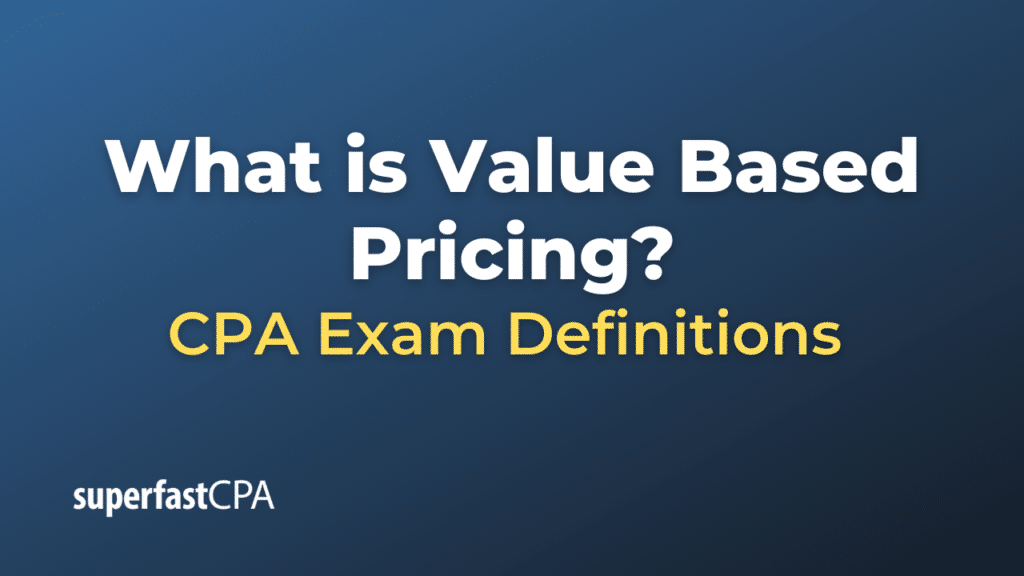Value Based Pricing
Value-based pricing is a pricing strategy that sets prices based on the perceived value of a product or service to the customer, rather than based on the cost of the product or historical prices. This approach disregards the traditional matrix of manufacturing cost, distribution cost, and retail markup to focus solely on the value it provides to the customer. The value is usually based on the maximum amount a customer is willing to pay for a particular product or service.
Here’s how value-based pricing generally works:
- Customer Research: The first step is to understand what the customer values in a product or service. This can be done through surveys, focus groups, and market research.
- Competitor Analysis: While the focus is on value, it is still important to understand how competitors are pricing similar offerings. This will provide a reference point and also help to identify potential value drivers that competitors are not addressing.
- Identify Value Drivers: These are the various elements or features of a product or service that customers value most. Value drivers could be anything from brand reputation and customer service to unique features and performance capabilities.
- Pricing Structure: Once value drivers are identified, a pricing structure is developed that takes into account these drivers. In some cases, this could lead to tiered pricing strategies where various levels of value are priced differently.
- Communication: The value proposition must be communicated effectively to the potential customer. If customers do not understand the value, they are unlikely to be willing to pay a premium for it.
- Review and Adjust: The market conditions and customer preferences are not static. Therefore, value-based pricing strategies should be reviewed and adjusted periodically.
Benefits of Value-Based Pricing:
- Higher Profit Margins: Because prices are based on value, and not costs, businesses often achieve higher profit margins.
- Customer Focus: The strategy aligns the business closely with customer needs and perceptions of value, often leading to higher customer satisfaction and loyalty.
- Flexibility: Value-based pricing allows for greater pricing flexibility and can be easily adapted to different market segments.
Challenges of Value-Based Pricing:
- Complex Research: Understanding the perceived value can be a complex and resource-intensive process.
- Vulnerable to Competitive Action: If a competitor introduces a similar product at a lower price point, it may require a reevaluation of the value-based pricing strategy.
- Customer Backlash: If customers feel that the pricing is not in line with the value offered, it could lead to negative reviews and loss of customer trust.
Value-based pricing is often used for products or services that have unique features or qualities that are highly valued by a specific customer group. This pricing strategy is common in various sectors, including technology, healthcare, luxury goods, and various types of services.
Example of Value Based Pricing
Let’s consider a software company that provides project management tools tailored for creative agencies. This is a niche market with specific needs that general project management tools may not meet effectively.
Steps in Value-Based Pricing for this Example:
- Customer Research: The company conducts surveys and focus groups within the creative agency community and finds out that features like real-time collaboration, task automation, and client approval workflows are highly valued. Also, creative agencies are willing to pay a premium for a tool that reduces project delivery times and enhances client satisfaction.
- Competitor Analysis: The company identifies that general project management tools are priced at around $20 per user per month. However, none of them offer the specialized features that creative agencies are looking for.
- Identify Value Drivers: Based on the research, value drivers are identified as real-time collaboration, task automation, and client approval workflows.
- Pricing Structure: The company decides to offer three tiers:
- Basic: $30 per user per month with limited features
- Professional: $50 per user per month with all core features
- Enterprise: Custom pricing for agencies that need additional customization and support
- Communication: The company develops marketing material that clearly articulates the benefits of their specialized tool and how it addresses the specific pain points of creative agencies.
- Review and Adjust: After six months, the company reviews customer feedback and usage data. They find out that the client approval workflow feature is a huge hit and even more valuable than they thought. They decide to further enhance this feature and communicate its benefits more prominently in their marketing.
Benefits Achieved:
- The company is able to price its product higher than general project management tools because it offers specialized value.
- The close alignment with customer needs results in higher customer satisfaction and loyalty.
- Tiered pricing allows them to cater to creative agencies of different sizes and budgets.
Challenges Faced:
- They had to invest substantially in initial research to identify the true value drivers.
- They are vulnerable to competitors who may come in with similar features at a lower price.
So, through value-based pricing, this hypothetical software company is able to effectively target a niche market, provide high value, and command a premium price for its specialized services.













